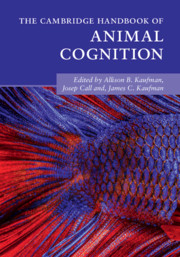Book contents
- The Cambridge Handbook of Animal Cognition
- The Cambridge Handbook of Animal Cognition
- Copyright page
- Dedication
- Contents
- Figures, Tables, and Boxes
- Contributors
- Acknowledgments
- Introduction
- Part I Communication and Language
- 1 Animal Communication Overview
- 2 Communication in Ant Societies
- 3 Symbolic Communication in the Grey Parrot
- 4 Communication in Dogs and Wolves
- 5 Semantic Communication in Primates
- Part II Memory and Recall
- Part III Social Cognition
- Part IV Social Learning and Teaching
- Part V Numerical and Quantitative Abilities
- Part VI Innovation and Problem-Solving
- Index
- References
4 - Communication in Dogs and Wolves
from Part I - Communication and Language
Published online by Cambridge University Press: 01 July 2021
- The Cambridge Handbook of Animal Cognition
- The Cambridge Handbook of Animal Cognition
- Copyright page
- Dedication
- Contents
- Figures, Tables, and Boxes
- Contributors
- Acknowledgments
- Introduction
- Part I Communication and Language
- 1 Animal Communication Overview
- 2 Communication in Ant Societies
- 3 Symbolic Communication in the Grey Parrot
- 4 Communication in Dogs and Wolves
- 5 Semantic Communication in Primates
- Part II Memory and Recall
- Part III Social Cognition
- Part IV Social Learning and Teaching
- Part V Numerical and Quantitative Abilities
- Part VI Innovation and Problem-Solving
- Index
- References
Summary
The ability to engage in some form of communication is essential for any social species. Communication generally relies on species-specific adaptations that provide animals with a cognitive tool to pass on messages from one conspecific to the other. This means that communication between members of different species is relatively rare and potentially requires qualitatively different cognitive abilities. This form of communication is not only challenging due to the fact that different species may rely on distinct sets of codes to convey messages but also because the primary modality used for this purpose may be different. Dogs represent a special case in the animal kingdom as they have been uniquely adapted to be receptive to the communicative signals of a species relatively distant in terms of their genome: humans. In this chapter, we will first focus on those characteristics of canids’ intraspecific communication that are shared between the dog and their phylogenetically closest relative, the wolf. Similarities in these forms of communication are likely the result of the common ancestry of the two species. Next, we turn to describing those attributes of canine communication that selectively pertain to how dogs communicate with their conspecifics. Finally, we discuss the ubiquitous nature of heterospecific communication between dogs and humans.
- Type
- Chapter
- Information
- The Cambridge Handbook of Animal Cognition , pp. 74 - 99Publisher: Cambridge University PressPrint publication year: 2021
References
- 1
- Cited by



